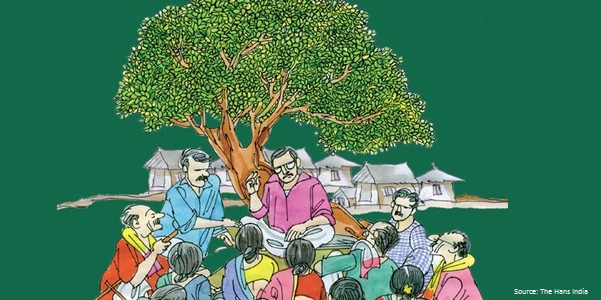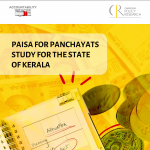
Panchayati Raj: Empty Coffers and the Mirage of Local Governance
6 July 2018
This year marks the silver jubilee of the 73rd and 74th constitutional amendments that led to the institutionalisation of Panchayati Raj in India. This was a landmark constitutional reform that had the disruptive potential to make democracy truly representative by ensuring decision making at the local tier, and holding governments accountable to people at that level. 25 years later, the slow pace of institutional reforms and the numerous bottlenecks have reduced Panchayati Raj Institutions (PRIs) to the role of paper-pushing agencies rather than a thriving arena of local governance.
The constitutional reforms primarily sought to bring about changes to the Indian political landscape through 2 mechanisms. First, it aimed at widening the democratic base and bring in political representation from across the country and across social groups. This has been fairly successful with elections to the panchayat seats being held regularly, and the number of elected panchayat representatives as of 2015 at 35 lakh i.e. an elected representative for every 3,700 people.
Secondly, the constitutional reforms aimed at creating PRIs as institutions of public service delivery and governance that would be responsive to local needs. This came against the growing realisation that real development could not take place without the participation of people. Political and economic theory shows that PRIs are better placed to coordinate locally available resources with the local needs of the people. Initial experiments with conferring power upon people’s representatives also revealed a number of positives: teacher attendance in primary schools improved; block development officers became more responsive to people’s needs; and importantly people were able to air their grievances to the elected representatives and obtain relief through them. These were clear pieces of evidence that PRIs enabled greater accountability in governance.
Given this rationale, the constitutional amendment law created several institutional reforms that would animate PRIs as well-functioning grassroots public service delivery institutions. In that regard, the law identified 29 subject matters in the 11th schedule of the amendment for which PRIs held sole responsibility. PRIs were to be given complete powers to plan and execute schemes for the functions pertaining to these 29 subjects. Several institutions that would enable bottom-up decentralised planning were given statutory status. District Planning Committees (DPC) were to be constituted in each district by the state governments; The DPCs were meant to coordinate and consolidate the planning process across the PRI tiers and formulate a development plan for the entire district. Gram Sabhas, in which every citizen of the panchayat was a member gained constitutional recognition as the fora for discussion and deliberation of Panchayat plans and proposals. Additionally, panchayat members were also expected to give updates on status of implementation of different schemes in the gram sabha. Further, Panchayats in several states have de jure provided for the implementation of social audits. Social audits are a powerful way to independently evaluate the performance of PRIs by the people.
Despite these forays into making governance at the grassroots a reality, any progress on getting the institutional reforms underway has met with several roadblocks. As a result of India’s federal political setup, each state has the right to pass their own panchayati raj act to legitimise PRIs and determine the extent of decentralisation within their state. While all states have passed the state panchayati raj act, the de facto operationalisation of these principles has lacked political will and left most Panchayats across the country toothless.
A basic tenet of decentralisation requires that funds follow function. In most states in India, several functions have been transferred to one of the PRI tiers notionally. However adequate funds have not been allotted for the panchayats to execute these functions. All states were required to constitute State Finance Commissions every 5 years to recommend tax and non-tax revenue assignments and fiscal devolution from the states to the PRIs. But the SFC institution has come under scathing criticism. Rather than carry forward the spirit of decentralisation through timely reforms, SFC reports have oftentimes been retrograde. In other cases, the SFC recommendations have been disregarded by the state governments or accepted notionally but not implemented. Barring a few states like Kerala and Karnataka, most other states present a depressing trend on the fiscal devolution front.
The constant tussle for power between the state line departments and the PRIs has also not been resolved despite 25 years of supposed institutional reforms. Panchayats have been given control of functionaries in only 9 states, and even there the line departments are allowed leeway to constantly subvert the Panchayat’s authority to determine locally relevant plans. District Planning Committees (DPC) in several states are headed by the district collector or a minister once again undermining PRI control.
Without funds and functionaries to carry out the functions assigned to them, PRIs in most states exist as vacuous symbols of authority.
The proliferation of centrally sponsored schemes further curtails the Panchayat planning space. Central ministries and state departments have set up parallel structures to implement development schemes on agriculture, health, education, social welfare, women and child development etc. all of which fall within the Panchayat functional domain. These parastatals by-pass the PRIs in all planning and decision making, and even when funds are routed through Panchayats it is given as “tied” grants. This reduces the role of PRIs to mere implementing agencies.
Thus, even as we have moved past the rhetoric of the need for greater democratic decentralisation and are in the implementation phase of PRIs, the state of affairs of Panchayati Raj in India dampens any exuberant romanticism that once surrounded it. One can only hope that sustained political participation at the grassroots level would soon translate into a strong demand for clear mandates of local functioning, greater ability to raise revenues and more autonomy of the Panchayats.




